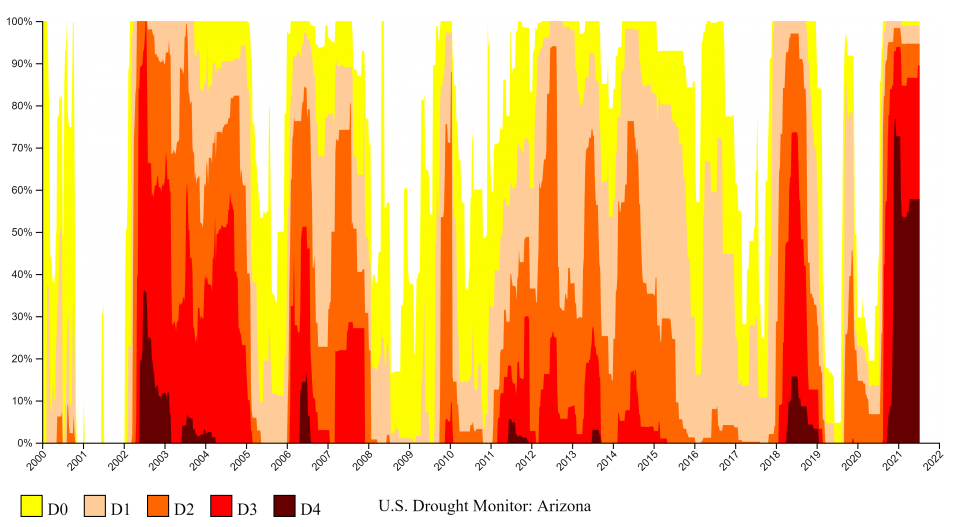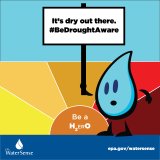Drought & WaterSense

It is always important to try to use water more efficiently—but there are times when it becomes even more important, such as when drought occurs. Drought happens somewhere in the U.S. every year. In 2021 the West is seeing some of the worst drought on record, following up on severe droughts in California during the 2014-2017 period. In September 2012, 65 percent of the country, including much of the Midwest, was in drought. Drought can be considered a slow motion natural disaster. During the 2012 drought, many communities struggled to provide important water services and economic losses were in the billions.
On this Page:
- Where is Drought Today?
- The New Normal?
- Be Drought Aware
- When in Drought
- More Information about Drought
Where is Drought Today?
The National Integrated Drought Information System provides a weekly update of the status of drought throughout the U.S. The map is updated every Thursday and they also provide a seasonal outlook.

The New Normal?
Every year, some part of the country experiences a drought. But in some parts of the country, it seems like there is a constant state of drought, which leads the public to ask "is drought the new normal?". Temperature and precipitation (snow and rain) patterns are changing and in some areas of the country the trends are toward hotter and drier conditions, particularly in the West. The map below shows the status of drought in Arizona between 2000 and 2021. The color scale is the same as the map above. You can find the recent drought history for your state on the NIDIS site.

Communities and the public are going to have to think differently about how they use water and how they plan their landscapes to respond to these conditions. Because outdoor water use becomes an issue during drier periods, it just makes "water sense" to design and plant landscapes that are more appropriate to the changing local climate.
Be Drought Aware

Maybe you are thinking, "Hey, when I turn on the tap, water comes out of it, so what is the problem?" That's probably true, because behind the scenes your local water utility is working hard to ensure that they can supply water for their community. But, the time could come when they may struggle and you might have to pay more for that water! Take the steps to be drought aware, so you can be prepared for shortages and help ensure that everybody in your community will be able to get water when they turn on the tap.
When in Drought
During a drought, your water utility may ask you to limit your outdoor watering or impose other restrictions. But all members of a community can step up their savings to ensure that water is available to meet critical needs. Here are some tips to keep in mind.
- Follow the rules: Your water utility must ensure water is available to fight fires and meet other critical needs, so help your community by following the rules. They will be lifted when water shortages end.
- Look for leaks: The last thing you want to do during a drought is waste water through leaks. Look for leaks indoors and out, and if you find them, fix them.
- Consider an upgrade: A drought is a great time to consider a bathroom makeover. You will help your utility with immediate savings and save yourself money on future bills. WaterSense labeled products are a great way to save!
- Take a sprinkler break: Outdoor water use can put a lot of stress on local water supplies. You can be water-smart by letting your grass grow longer and making other maintenance adjustments. Grass doesn’t need to be green year round—you can cut back on watering and the green will return when rains return. WaterSense has lots of water-saving tips for drought resilient landscapes. If you’re interested in some quick-fix tips for the summer months, see our When It’s Hot page.
- Go the extra mile: If you want to go above and beyond in water savings, think about reusing water. You can collect water in a bucket while waiting for the shower to warm up or when washing pots, and use it to water container plants or flower beds. Use your imagination to come up with creative ways to save water or see more WaterSense tips on our start saving page.
This information is also available in PDF format on our Drought Fact Sheet (1 pp, 672 K, About PDF) and en Español.
All parts of a community can help out in a drought. The one pagers below describe some actions that specific sectors can take to save water in their community.
- Help Out in a Drought-Apartments and Dorms (pdf)
- Help Out in a Drought-Residents and Homeowner Associations (pdf)
- Help Out in a Drought-Lawn Maintenance and Irrigation Professionals (pdf)
- Help Out in a Drought-Landscapers and Garden Professionals (pdf)
- Help Out in a Drought-Restaurants and Hotels (pdf)
More Information on Drought
- EPA Drought Response and Recovery for Water Utilities
- Funding with the EPA State Revolving Funds
- EPA's Water Reuse Action Plan highlights water reuse actions that can be part of a drought resilience strategy.
- Drought.gov (Drought Monitor and National Integrated Drought Information System)
- National Drought Mitigation Center
- AWWA Water Conservation and Drought Preparedness Resources
